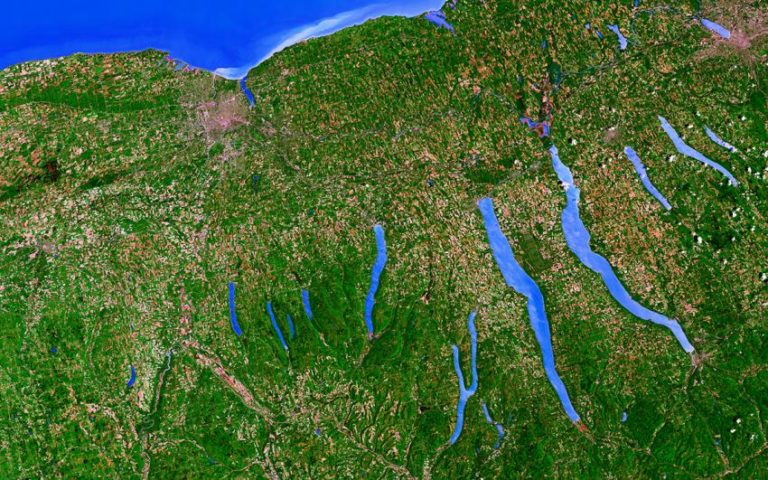 The area bordered by the Genesee River to the West, Lake Ontario to the north, the four western Finger Lakes to the south, and the drumlin fields from the most eastern of the Finger Lakes (Honeoye) up toward Lake Ontario, comprises the Genesee River watershed on the Erie-Ontario Plain. This continental landform was influenced heavily by repeated glaciations, with the final recession occurring around 10,000 years ago. These influences can be seen in both the topography and the soil.
The area bordered by the Genesee River to the West, Lake Ontario to the north, the four western Finger Lakes to the south, and the drumlin fields from the most eastern of the Finger Lakes (Honeoye) up toward Lake Ontario, comprises the Genesee River watershed on the Erie-Ontario Plain. This continental landform was influenced heavily by repeated glaciations, with the final recession occurring around 10,000 years ago. These influences can be seen in both the topography and the soil.
All the rocks in the Genesee region are sedimentary (shale, siltstone, sandstone, limestone, dolostones, gypsum and salt) in origin, and represent the Ordovician, Silurian and Devonian periods, with glacial sediment forming the uppermost layer (Van Diver, 1980, p. 76). These early rocks hold fossils which speak of a time some 450 million years ago when the continent lay further south, the global climate was warmer overall, and the region was submerged in “warm, shallow seas, in which coral and other marine life flourished” (Van Diver, 1980, p. 80). As a result, our regional soils are mainly medium to high range in lime (USDA, 1973, p. 9).
The last glaciation (Wisconsin) shaped the land in highly distinctive ways. Notable among them are the Albian-Rochester moraine, which is considered the “most northerly well-defined moraine in the western end of (New York) state” (Fairchild, 1923, p. 142). This landform, created from an accumulation of glacial till at the spot where the glacier paused in its retreat, runs across the southern border of the City of Rochester. It is unquestionably the most outstanding topographic feature of the city. Subject to considerable degradation since European settlement of the region, it now takes the form of a series of variously “developed” hills separated by major north-south urban arteries.
The Genesee River system bisects the city of Rochester. More accurately, the city developed around and because of this life-giving river. It is “the only major river that maintains its preglacial northward flow despite diversions and obstructions introduced by continental glaciation during the ice age” (Van Diver, 1980, p.75). This amazing river, it’s pre-Wisconsin path obstructed by a moraine some 80 miles south of present-day Rochester, found a new course, pouring over an escarpment, into and northward through a valley to create what has been called the “Grand Canyon of the east” at Letchworth. Aboriginal peoples clustered their camps on its edges, as did the European settlers who entered the region in the late 18th century and built mills along the mighty waterfall section that is now downtown Rochester.
The glacier also left many footprints in the form of drumlins, north-south trending, low, streamlined hills that are found abundantly from Syracuse to the west beyond Rochester. These distinctive and unusual landforms number in the 10,000 range and comprise one of the world’s largest and finest drumlin fields (Van Diver, 1980, p.227).
Finally, the eleven glacially-formed Finger Lakes (the three western lakes being part of the Genesee Valley bioregion) are unique throughout the world in their shape, layout, and drainage. Like the Genesee River, all eleven lakes drain to the north, in this case due to damming in the south by a moraine (Van Diver, 190, p. 119).
Read the full paper: Sense of Place – Eco Autobiography
References: Ecological Autobiography References